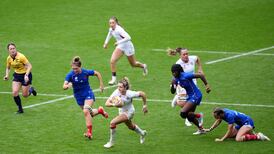On Gaelic Games:The dazzle of lights last Saturday night shouldn't blind us to some interesting trends that have emerged from what was a satisfying and celebratory occasion. Sometimes the GAA can go on a bit about the stadium and the association's foresight in building it at a time of uncertainty and how spirited an undertaking it was in the absence of any public funding commitments
But all of that is largely true.
The new Croke Park has given a great confidence to the association. Part of this naturally comes from financial stability now that the project is complete but the greater influence is simply pride in the achievement of having built a top-rank stadium that has brought unforced admiration for the GAA from a wider audience.
Of all the many things the association has done for society at large - develop a sporting infrastructure, contribute through its activities to local economies and foster a sense of community - the completion of Croke Park curiously stands out as the one that has earned unambiguous praise rather than ambivalent recognition.
So marked has been this phenomenon that the findings of the GAA's marketing sub-committee, appointed during Seán Kelly's presidency and the source of a mysteriously unpublished report, caused concern about the fact that as a brand Croke Park earned approval ratings that far outstripped the GAA as a whole.
But there has also been a noticeable confidence about the GAA since the new venue has materialised. Deciding to test drive the new floodlights for an ordinary National Football League fixture, albeit the season's inaugural match, was a potential risk.
The idea was the right one, to open the completed facility to Gaelic games before the guest sports arrive, but had there not been a huge crowd the initiative would have fallen a little flat and created a perceived discrepancy however superficial between the appeal of the GAA's own events and the rugby international a week later.
Instead the evening was an enjoyable affirmation of the undiminished appeal of Gaelic games even in the era of relentlessly hyped professional sport, its commoditisation and mass consumption.
The presence of over 80,000 was also an indication of how competition status has been changed by GAA innovation during this decade.
There has often been a sense of paradox about the football league. During the 1990s only one county managed to add the All-Ireland to a league title in the same year - Kerry, blessed as they were with the luxury of not having to face Division One opposition in the championship for over three months after their spring success, the sort of dispensation that no longer exists.
Of the other 11 league winners between 1990 and 2001 (the season the qualifiers and calendar-year format radically changed football) only three even got out of their province later that summer.
Thus it became an undesirable title to pursue, an attitude understandable in the context of, for example, Dublin's record in the late 1980s/early 1990s. For nine years from 1986, the county reached the play-offs each season, losing two finals and winning three titles. Not once did an All-Ireland follow. Then in the 10th season Dublin not alone failed to qualify for the knockout stages but were relegated. A few months later they were All-Ireland champions.
Changes to the competition calendar have completely reversed that perception - or reality. Only four counties have contested the past five All-Irelands, Mayo, Tyrone, Kerry and Armagh, and they are the last four counties to have won the National League.
This year's league carries even further significance because finishing position will determine next year's status.
So Saturday night was an important enough match as well as a big event and both sides understood that. But it was also more evidence of an emerging pattern that had been referred to by GAA director general Liam Mulvihill at the launch of the league last week.
"I just wish that we would have a sell-out for the final game of the league," he said. "It has been one of the features of the league that, whereas most competitions start with a whimper and end with a bang, the leagues have tended to start with a bang and end with a whimper. It would be my sincere wish that that wouldn't happen this year."
It's probably too late for that in that it's hard to imagine the final emulating Saturday's sense of occasion and certainly that won't happen unless Dublin go the distance.
Watching the hordes of supporters present at the weekend it was hard to believe that in the final of eight years ago - played in Cork under the invocation of some ancient "home-and away" arrangement - fewer than 10,000 turned up in Páirc Uí Chaoimh. And never mind eight years; it's only nine months since even fewer turned up in Limerick for the 2006 final.
The calendar year has whetted the appetite for a resumption of intercounty activity but by the end of the league people's minds have wandered towards the serious business of the summer.
At this stage it's worth reconsidering the idea of abandoning the play-off stages. Seven matches for everyone up until the beginning of April, leaving a few weeks before the championship gets started. No play-offs, no knockout - just top the table wins. This would give everyone the same number of preparatory matches leading up to the summer season. It would also leave the requisite time free for club matches as agreed by last autumn's special congress.
The GAA have so far adapted to modern realities very successfully in maintaining the profile of their elite competitions. But the need for adaptation is a constant. Evolution can't stop just because everyone's pleased with themselves.












